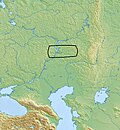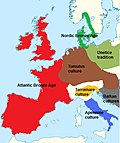 | a major role in the development of the Sintashta culture and Srubnaya culture. The Abashevo culture is believed to have formed on the northern Don in... 25 KB (2,936 words) - 17:15, 15 April 2024 |
 | Srubnaya culture. The Catacomb culture emerged on the southern part of the Pontic steppe in 2,500 BC, as a western descendant of the Yamnaya culture.... 28 KB (3,366 words) - 05:13, 19 April 2024 |
 | culture, as well as the peoples of the Sintashta, Andronovo, and Srubnaya cultures. Back migration from Corded Ware also contributed to Sintashta and... 67 KB (6,937 words) - 08:30, 30 April 2024 |
 | culture, the Srubnaya culture, the Potapovka culture, and the Andronovo culture. These were found to harbor mixed ancestry from the Yamnaya culture and... 46 KB (4,900 words) - 19:11, 27 April 2024 |
 | Sintashta culture, its people are believed to have spoken a form of Proto-Indo-Iranian. It was directly ancestral to the Srubnaya culture, and probably... 16 KB (1,841 words) - 07:37, 11 April 2024 |
Androphagi (section Society and culture) of the Srubnaya culture containing a significant element originating from the Siberian Andronovo culture. The population of the Srubnaya culture was among... 19 KB (2,085 words) - 00:12, 24 December 2023 |
 | Scythians (section Culture and society) of the Srubnaya culture containing a significant element originating from the Siberian Andronovo culture. The population of the Srubnaya culture was among... 277 KB (32,473 words) - 16:27, 28 April 2024 |
 | Cycladic culture (also known as Cycladic civilisation or, chronologically, as Cycladic chronology) was a Bronze Age culture (c. 3100–c. 1000 BC) found... 14 KB (1,538 words) - 13:54, 29 April 2024 |
Noua-Sabatinovka-Coslogeni complex (category Archaeological cultures of Europe) Noua, Sabatinovka and Coslogeni cultures. The complex originated from a westward migration related to the Srubnaya culture from the steppe and forest-steppe... 6 KB (548 words) - 17:35, 24 April 2024 |
 | Kurgan hypothesis (redirect from Kurgan culture) prehistoric cultures, including the Yamnaya (or Pit Grave) culture and its predecessors. In the 2000s, David Anthony instead used the core Yamnaya culture and... 34 KB (3,825 words) - 14:41, 30 April 2024 |
Sauromatian culture emerged during the 6th century BCE out of elements of the Bronze Age Srubnaya culture and the neighbouring Andronovo culture, combined... 54 KB (6,116 words) - 22:59, 12 April 2024 |
 | Indus Valley Civilisation (redirect from Indus Valley Culture) and later cultures called Early Harappan and Late Harappan in the same area. The early Harappan cultures were populated from Neolithic cultures, the earliest... 187 KB (21,221 words) - 21:04, 1 May 2024 |
 | The Apennine culture is a technology complex in central and southern Italy from the Italian Middle Bronze Age (15th–14th centuries BC). In the mid-20th... 10 KB (1,174 words) - 08:41, 18 March 2024 |
 | The Hallstatt culture was the predominant Western and Central European archaeological culture of the Late Bronze Age (Hallstatt A, Hallstatt B) from the... 76 KB (8,519 words) - 22:53, 23 April 2024 |
Srubnaya culture, and, archaeologically, the Scythian movement into Transcaucasia is attested in the form of a migration of a section of the Srubnaya... 29 KB (3,583 words) - 04:29, 8 April 2024 |
 | same individual, 2134–1950 cal BC, which could actually belong to Srubnaya culture period, as Haplotree Information Project considers this sample I6561... 22 KB (2,508 words) - 21:30, 29 April 2024 |
Budini (section Society and culture) the Srubnaya culture containing a significant element originating from the Siberian Andronovo culture. The population of the Srubnaya culture culture was... 17 KB (1,923 words) - 09:50, 30 December 2023 |
 | Minoan civilization (redirect from Minoan culture) The Minoan civilization was a Bronze Age culture which was centered on the island of Crete. Known for its monumental architecture and energetic art, it... 114 KB (13,577 words) - 04:15, 28 April 2024 |











